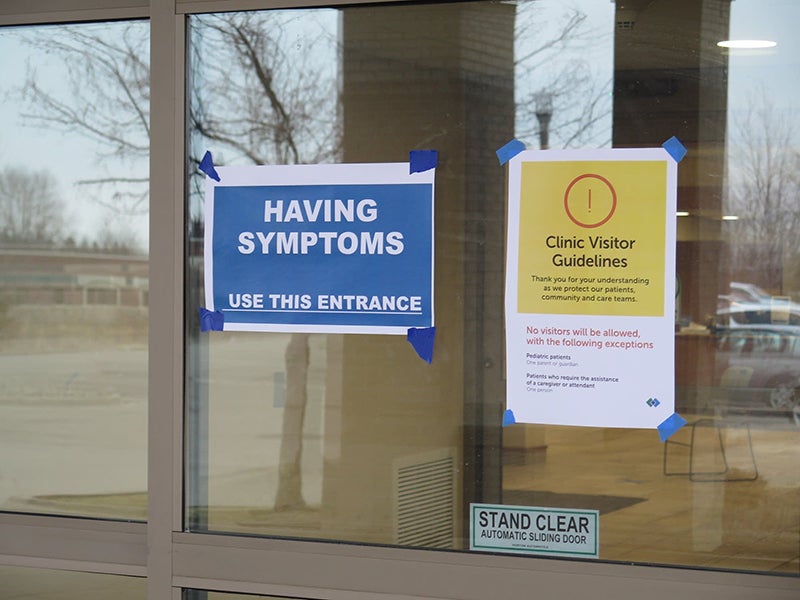Bar-driven cluster surfaces in southern Minnesota
Published 3:28 pm Wednesday, June 24, 2020

- Two signs posted on the door of HealthPartners's Stillwater Medical Group clinic in March. Health officials say they’re increasingly concerned that people with serious health problems who need emergency room care are not seeking that care and that parents are not keeping up with regular vaccinations for their children because of COVID-19 fears.Mark Zdechlik/MPR News file
|
Getting your Trinity Audio player ready...
|
Despite some hopeful trends in COVID-19 hospitalizations and deaths, Minnesota officials now worry that many people — especially young adults — aren’t doing enough to help minimize the spread of COVID-19 as they return to social spaces.
Minnesota’s now dealing with a virus cluster of roughly 100 cases in south-central Minnesota of people in their 20s who said they visited bars on June 12 and 13, Kris Ehresmann, the state’s infectious disease director, told reporters Wednesday.
While those young people may be less likely to suffer complications from COVID-19, the concern is that they may be inadvertently spreading the disease to grandparents or other vulnerable populations.
Ehresmann implored all Minnesotans to wear masks and keep their distance from others while in indoor social spaces. “I don’t want to suggest that we don’t want people to have fun. The concern is if there’s crowding.”
Death rate slows; hospitalizations stable
Ehresmann’s remarks came hours after the state Health Department reported five more deaths related to COVID-19, putting the total at 1,397 since the pandemic began.
The trends, though, continue to show a slowing death rate. Wednesday marked the first time since mid-April that the state reported four consecutive days of deaths in the single digits.
The counts of people currently hospitalized (340) and needing intensive care (160) — two closely watched metrics as officials try to manage the spread of the disease — stayed roughly stable but still showed an overall downward trend the past few weeks.
Of the 33,763 confirmed cases of COVID-19 since the outbreak began, state officials say about 88 percent of those infected have recovered to the point they no longer need to be isolated.
Among those who’ve died, nearly 80 percent were living in long-term care or assisted living facilities; nearly all had underlying health problems.
Racial disparities
State officials have been encouraging people who participated in protests following the killing of George Floyd to get tested for COVID-19.
The Health Department has offered free testing in Minneapolis and St. Paul the past two weeks.
While officials have been encouraged that positive case are less than 2 percent, the testing has revealed some stark racial disparities.
Ehresmann said results of two weeks of that testing showed wide differences in the rates of positive results for COVID-19. She said the positive rate for whites was 0.2, but for Blacks it was 1.3 percent, 5 percent Asian, and 7.4 percent Latino.
Moreover, people of color made up 40 percent of those tested, but 90 percent of the positives.
Ehresmann said the data reinforces her agency’s concern over racial disparities “due to differences in rates of underlying health conditions and job exposure risk.”
Avoiding the ER?
The newest numbers came as Minnesota health officials say they’re increasingly concerned that people with serious health problems who need emergency room care are not seeking that care amid COVID-19 fears.
It’s especially worrisome for people who might be suffering heart attacks, strokes or low blood sugar, Ehresmann said earlier in the week. She cited national data showing double-digit percentage drops in emergency room visits compared to the weeks before it hit the United States.
Officials at Robbinsdale hospital have seen drops across the board, including for heart attacks and strokes.
According to a Centers for Disease Control and Prevention report released Monday, in the 10 weeks following the declaration of COVID-19 as a national emergency, emergency rooms saw a 23 percent drop in heart attack patients, a 20 percent stroke patients and a 10 percent drop in uncontrolled high blood sugar.
Ehresmann and Minnesota Health Commissioner Jan Malcolm also reiterated ongoing worries that parents are not keeping up with regular vaccinations for their children because of COVID-19 fears.
According to the Minnesota Department of Health, the number of measles, mumps and rubella vaccine doses given out this year has been down by as much as 70 percent, from the same week in 2019, though that gap narrowed to around 35 percent last week.
Children’s Minnesota, the pediatric hospital system in St. Paul and Minneapolis, says it has dispensed far fewer vaccines than normal.
“When we look at Children’s in terms of total doses, we’ll give between 800 and 1,000 infant vaccines a month. And during the pandemic, we dropped down to right around 400, or less than 400 a month,” said Patsy Stinchfield, a pediatric nurse practitioner in infectious disease at Children’s.
Stinchfield said this month the number of vaccinations is rising, but still not quickly enough. “What we worry most about is measles because it’s so contagious,” Stinchfield said.
Children’s has opened up drive-up immunizations to make them more convenient. They’re also encouraging families to vaccinate their children.
Health Department officials say this year it’s very important for people to get their influenza vaccine, as the flu looks similar to COVID-19 but can also take up medical resources through the winter.
Meatpacking hot spots remain
Many of the outbreaks outside the Twin Cities metro area are focused around meatpacking plants. Officials have intensified testing in those hot spots, uncovering more infections.
That includes Mower County in southeastern Minnesota, where there were 828 confirmed cases as of Wednesday.
Mower County is home to Hormel Foods and Quality Pork Processors. Both have been partnering with Mayo Clinic to ramp up employee testing.
While some of Mower County’s positive cases are associated with people who work in the facilities and with the people they live with, county officials say they are also seeing transmission among people who live in the county but work in other counties where coronavirus is present.
Health officials held a COVID-19 testing push in Austin, Minn., over the weekend.
Nobles, in southwestern Minnesota, reported 1,635 confirmed cases Wednesday. About 1 in 14 people now have tested positive for COVID-19 in the county, although there have only been a few additional cases recorded the past few days.
Worthington’s massive JBS pork processing plant was the epicenter of the Nobles outbreak. The JBS plant shut on April 20 but has since reopened with expanded hygiene and health monitoring measures.
Similar problems have been reported in Stearns County, where COVID-19 cases tied to two packing plants — Pilgrim’s Pride poultry plant in Cold Spring and Jennie-O Turkey in Melrose — skyrocketed in May.
An undisclosed number of workers at both plants have tested positive for the virus. There were about 55 confirmed cases in Stearns County in early May. By Tuesday, confirmed cases were at 2,140 with 19 deaths.
Kandiyohi County in west-central Minnesota is also seeing cases continue to climb more than a month after officials with the Jennie-O turkey processing plant there said some employees had tested positive for the coronavirus. The county had confirmed three COVID-19 cases then.
As of Wednesday, the Health Department reported 561 people have now tested positive in the county, the same as Tuesday.
Cases have also climbed noticeably in Cottonwood County (126 cases), home to a pork processing plant in Windom, and in Lyon County (279 cases), around a turkey processor in Marshall.
Youth sports may resume soon
State health officials have announced that youth sports can resume in the coming weeks. Outdoor sports can return to games and scrimmages starting Wednesday, and indoor sports July 1 or later, under the Health Department’s recommended guidance.
Among the recommendations, the department calls on players to:
- Avoid sharing individual water bottles, community snacks or towels
- Try to use “dedicated personal equipment” such as bats, mitts and rackets
- Find new ways to show sportsmanship, including “tip your hats instead of handshakes.”
While following the guidance can help reduce risk, “in the end everyone has to make their own decisions about what level of risk they are willing to accept,” Health Commissioner Jan Malcolm said.
Officials also said the Minnesota Department of Education is working with the Minnesota State High School League to develop activities and sports guidance for schools for the fall sports season.




